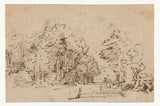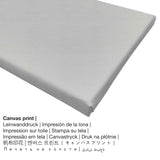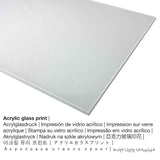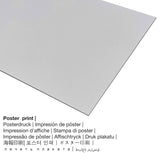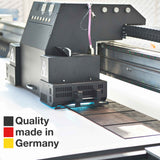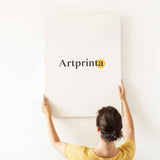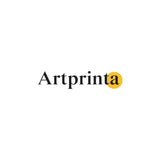Rembrandt van Rijn, 1660 - Amstelveenseweg N'èzí Amsterdam - ọmarịcha nka.
Ụtụ gụnyere. Mbupu gbakọrọ na ndenye ọpụpụ.
Nhọrọ ihe onwunwe
Maka akwụkwọ nka ọ bụla dị mma anyị na-enye ihe dị iche iche na nha. Anyị na-ahapụ gị ka ịhọrọ nha na akụrụngwa ọkacha mmasị gị n'etiti nhọrọ nhazi ngwaahịa ndị a:
- Akwụkwọ mmado ebipụtara (akwa akwa akwa): A poster print is a UV printed canvas with a fine surface texture. Please note, that depending on the size of the canvas poster print we add a white margin 2-6cm round about the print in order to facilitate the framing with a custom frame.
- Mbipụta iko acrylic (nke nwere ezigbo mkpuchi iko): An print on acrylic glass, which is sometimes described as a an art print on plexiglass, will change the original artwork into beautiful décor. The artwork is manufactured with modern UV direct print technology. The major advantage of a plexiglass print is that sharp contrasts and smaller painting details become exposed thanks to the very fine gradation in the picture.
- Mbipụta nke aluminom: An Aluminium Dibond print is a print material with an outstanding effect of depth - for a modern look and non-reflective surface. A direct Direct Print on Aluminum Dibond is your perfect start to art reproductions on aluminum. For our Direct Print On Aluminum Dibond, we print your chosen work of art onto the surface of the aluminum material. The bright components of the artwork shine with a silk gloss but without glow. The colors are vivid and luminous, details of the print appear clear and crisp.
- Mbipụta kanvas: The printed canvas, not to be mistaken with a canvas painting, is a digital replica applied onto canvas fabric. Further, a printed canvas makes a cosy and pleasing look. Hanging your canvas print: The great advantage of canvas prints is that they are relatively low in weight, which means that it is easy to hang up your Canvas print without the support of any wall-mounts. Because of thatcanvas prints are suitable for all types of walls.
Disclaimer: We try the best we can in order to depict our products as clearly as we can and to showcase them visually. At the same time, the tone of the printing material and the printing may diverge to a certain extent from the representation on the device's monitor. Depending on the screen settings and the condition of the surface, not all color pigments will be printed one hundret percent realistically. Considering that all our are printed and processed by hand, there may as well be minor differences in the exact position and the size of the motif.
Nkọwa ndị ọzọ sitere na Rijksmuseum (© - site na Rijksmuseum - www.rijksmuseum.nl)
An inventory of Rembrandt’s possessions was drawn up when he declared bankruptcy in 1656. In it was mentioned a large group of landscape drawings ‘naer ’t leven’ (from life). And, indeed, on the basis of Rembrandt’s sketches we can follow the artist on his walks in the countryside around Amsterdam. The short stakes separating the roadway from the footpath on the Amstelveenseweg are clear to see in this fairly late drawing.
Nchịkọta nke akwụkwọ nka "Amstelveenseweg n'èzí Amsterdam"
Amstelveenseweg n'èzí Amsterdam was created by Rembrandt van Rijn in 1660. Nowadays, this work of art forms part of the art collection of Rijksmuseum, nke bụ nnukwu ihe ngosi nka maka nka na akụkọ Dutch site na Middle Ages ruo ugbu a. Site n'ikike nke: Rijksmuseum (public domain license).The creditline of the artpiece is the following: . In addition to this, the alignment of the digital reproduction is in landscape format with a side ratio of 3 : 2, meaning that the length is 50% longer than the width. The painter Rembrandt van Rijn was an artist, whose art style was primarily Baroque. The Baroque artist was born in 1606 na Leiden ma gafee na afọ nke 63 n'afọ 1669.
Nkọwa gbasara ihe nka
| Aha nka: | "The Amstelveenseweg Outside of Amsterdam" |
| Nchịkọta nke ọrụ nka: | sere |
| Nhazi nka: | nka ochie |
| Narị afọ nka: | 17th narị afọ |
| Emepụtara na: | 1660 |
| Afọ nka: | karịa afọ 360 |
| Ụlọ ihe ngosi nka: | Rijksmuseum |
| Ebe ngosi nka: | Amsterdam, Netherlands |
| Webụsaịtị ihe ngosi nka: | www.rijksmuseum.nl |
| Ụdị ikike nka: | ngalaba ọha |
| Site n'aka: | Rijksmuseum |
Banyere akụkọ
| Bipụta ngwaahịa: | nka nka |
| Usoro mmeputakwa: | mmeputakwa n'ụdị dijitalụ |
| Usoro mmepụta: | mbipụta dijitalụ |
| Production: | German mmepụta |
| Stockdị ngwaahịa: | mmepụta ihe na-achọ |
| Ojiji ngwaahịa: | ihe ndozi mgbidi, gallery mgbidi |
| Ndozi onyonyo a: | usoro odida obodo |
| Ụdị anya: | 3:2- (ogologo: obosara) |
| Akụkụ onyonyo pụtara: | ogologo bụ 50% ogologo karịa obosara |
| Ụdị ihe dị iche iche: | akwụkwọ mmado (akwụkwọ kwaaji), mbipụta ọla (aluminium dibond), mbipụta kanvas, mbipụta iko acrylic (nwere ezigbo mkpuchi iko) |
| Mbipụta kanvas (akwa akwa na etiti ihe ndọtị): | 30x20cm - 12x8", 60x40cm - 24x16", 90x60cm - 35x24", 120x80cm - 47x31", 150x100cm - 59x39" |
| Acrylic glass print (nwere ezigbo mkpuchi iko) nhọrọ: | 30x20cm - 12x8", 60x40cm - 24x16", 90x60cm - 35x24", 120x80cm - 47x31", 150x100cm - 59x39" |
| Nhọrọ nha nke akwụkwọ mmado (akwụkwọ kwaaji): | 60x40cm - 24x16", 90x60cm - 35x24", 120x80cm - 47x31" |
| Mpempe akwụkwọ Dibọn (ihe alumnium): | 30x20cm - 12x8", 60x40cm - 24x16", 90x60cm - 35x24", 120x80cm - 47x31" |
| Nhazi mbipụta nka: | agunyeghi |
Tebụl nyocha nke onye na-ese ihe
| Aha onye nka: | Rembrandt van Rijn |
| okike nke onye nka: | nwoke |
| Obodo onye nka: | Dutch |
| Ọrụ nke onye na-ese ihe: | onye na-ese ihe |
| Obodo onye nka: | mba netherland |
| Nkewa onye nka: | nna ukwu ochie |
| Ụdị nke onye na-ese ihe: | Baroque |
| Ndụ: | 63 afọ |
| Afọ ọmụmụ: | 1606 |
| Obodo ọmụmụ: | Leiden |
| Afọ ọnwụ: | 1669 |
| Obodo ọnwụ: | Amsterdam |
Ederede a bụ ikike ọgụgụ isi ma chekwaa ya site na nwebisiinka © | www.artprinta.com (Artprinta)

